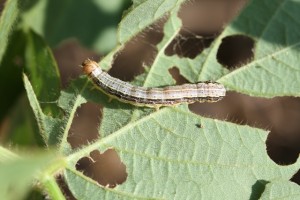I’m not sure what a bug thinks, but I don’t think they are deep thinkers. We have that in common, but at least I know we’ve pretty much wrapped up this season in terms of insect control. Below are the last few reminders as we close out this year’s crop.
 Pastures: Fall armyworms have been quite the scourge in our pastures throughout the state. It appears infestations have subsided. But continue to watch any pastures that you plan to cut one more time. Populations may rebound, and these critters can potentially hang around until the first frost. Refer to my previous article if you need a refresher on when and with what to treat.
Pastures: Fall armyworms have been quite the scourge in our pastures throughout the state. It appears infestations have subsided. But continue to watch any pastures that you plan to cut one more time. Populations may rebound, and these critters can potentially hang around until the first frost. Refer to my previous article if you need a refresher on when and with what to treat.
Soybean: With the exception of stink bugs, insect problems in soybean are generally mild. It appears many of the loopers and green cloverworms have succumbed to various diseases. Stink bugs still remain a threat to our latest fields, and many fields are at or approaching treatment levels. I discussed when or when not to treat in a recent article. It is treatment level infestations that start before R6 which have the greatest potential to reduce yields. Many people will elect not to spray fields because of the concerns about sprayer damage. This is a legitimate concern, especially if you are spraying narrow rows, with a small boom width, and its even worse in smaller fields where a lot of turning is required. I’ve seen research indicating anywhere from 0-4 bushel loss from tire tracks depending upon row width, boom wide, maturity of the crop, etc. This is good reason to consider hiring an airplane when a spray is needed.
Wheat: I’ll touch on this topic more in the near future. However, this is a good time to remind people to NOT plant too early. Plantings before the fly free date (Oct. 15), and particularly those in September, are much more likely to be infested during the fall with Hessian flies and aphids. You should also consider this if using wheat for a cover crop. This can build populations of Hessian flies that attack nearby fields.

